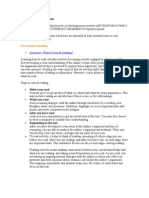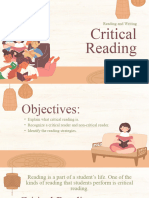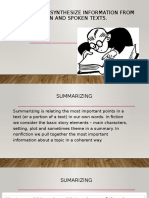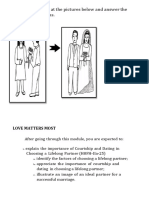0 ratings0% found this document useful (0 votes)
20 viewsCritical Thinking and Reading
Critical Thinking and Reading
Uploaded by
Ricky CementThis document outlines the key components of critical thinking and reading. It discusses critical thinking and reflective thinking, and how they are often used interchangeably. Critical thinking involves purposeful, reasoned thinking to achieve goals, while reflective thinking focuses on analyzing past events. The document also outlines the requirements of active critical thinkers, including questioning sources and forming supported opinions. Finally, it details the components of close, critical reading: reading to understand, respond, evaluate, and synthesize information from multiple sources.
Copyright:
© All Rights Reserved
Available Formats
Download as PDF, TXT or read online from Scribd
Critical Thinking and Reading
Critical Thinking and Reading
Uploaded by
Ricky Cement0 ratings0% found this document useful (0 votes)
20 views19 pagesThis document outlines the key components of critical thinking and reading. It discusses critical thinking and reflective thinking, and how they are often used interchangeably. Critical thinking involves purposeful, reasoned thinking to achieve goals, while reflective thinking focuses on analyzing past events. The document also outlines the requirements of active critical thinkers, including questioning sources and forming supported opinions. Finally, it details the components of close, critical reading: reading to understand, respond, evaluate, and synthesize information from multiple sources.
Original Description:
communication
Original Title
2. Critical Thinking and Reading
Copyright
© © All Rights Reserved
Available Formats
PDF, TXT or read online from Scribd
Share this document
Did you find this document useful?
Is this content inappropriate?
This document outlines the key components of critical thinking and reading. It discusses critical thinking and reflective thinking, and how they are often used interchangeably. Critical thinking involves purposeful, reasoned thinking to achieve goals, while reflective thinking focuses on analyzing past events. The document also outlines the requirements of active critical thinkers, including questioning sources and forming supported opinions. Finally, it details the components of close, critical reading: reading to understand, respond, evaluate, and synthesize information from multiple sources.
Copyright:
© All Rights Reserved
Available Formats
Download as PDF, TXT or read online from Scribd
Download as pdf or txt
0 ratings0% found this document useful (0 votes)
20 views19 pagesCritical Thinking and Reading
Critical Thinking and Reading
Uploaded by
Ricky CementThis document outlines the key components of critical thinking and reading. It discusses critical thinking and reflective thinking, and how they are often used interchangeably. Critical thinking involves purposeful, reasoned thinking to achieve goals, while reflective thinking focuses on analyzing past events. The document also outlines the requirements of active critical thinkers, including questioning sources and forming supported opinions. Finally, it details the components of close, critical reading: reading to understand, respond, evaluate, and synthesize information from multiple sources.
Copyright:
© All Rights Reserved
Available Formats
Download as PDF, TXT or read online from Scribd
Download as pdf or txt
You are on page 1of 19
The Polytechnic
LAN - EAP/ELS - 111
Critical
Thinking/Reading
January, 2021
Lecturer: Romeo Katanga
Semester 1
Outline
➢ Critical thinking and reading
Critical Thinking/Reflection and
Reading
➢ Critical thinking and reflective thinking are
often used synonymously
a) Critical Thinking
• Critical means “active” and “Positive”
• It is the thinking that is purposeful, reasoned
and goal directed
• Critical Thinking involves a wide range of
thinking skills leading toward desirable
outcomes
b) Reflective thinking
• reflective thinking focuses on the process of
making judgments about what has happened.
• This is a part of the critical thinking process
referring specifically to the processes of
analyzing and making judgments about what has
happened.
• Reflective thinking is an active, persistent, and
careful consideration of a belief or supposed
form of knowledge, of the grounds that
support that knowledge, and the further
conclusions to which that knowledge leads.
Requirements in Critical thinking
a. Active, critical thinkers search for and question
similarities and differences
• More sources always present similarities and
differences
b. Active critical thinkers challenge and are challenged
by sources
Challenge the author: Ask questions of the
sources
• Identify central Problem to explore and reasons
• Identify most important statement made
• Identify the author etc.
Challenge yourself: Ask questions of yourself
• Critical reading points in two directions: text
you are reading and you, especially origin of
your views
c. Active Critical thinkers set issues in a broader
context
• Identify issues that are important to a single
reading selection. The larger context is not
obvious.
• Techniques to discovering larger context
i. Begin by identifying one or more issues that
you think are important to a text
ii. Assume that each issue is an instance or
example, of something larger. Your job is to
speculate.
iii. Write the name of the issue at the top of a
page followed by a question: What is this
part of ?
iv. Use this broader context to stimulate more
thought on the reading selection and to
generate questions.
v. Option: Investigate other reading selections
d. Active critical thinkers will form and support
opinions
• Opinions follow from responses to questions
such as:
i. Has the author explained things clearly?
ii. In what ways does this topic confuse me?
iii. Has the author convinced me of his or her
main argument?
iv. What is my view on this topic?
v. Would I recommend this source to others?
Components of a close, critical
reading
• Reading is intended to understand, respond,
evaluate and synthesize.
Reading to understand
• Identify the author’s purpose such as to inform or
argue.
• Identify the author’s intended audience, text to be
written with particular readers in mind
• Locate the authors intended audience- think of
readers
• Understand the structure of the text – locate main
points
• Identify as quickly as possible what you do not
understand
• Reading to understand entails reading in three
stages:
i. Preview: skim text –reading quickly
ii. Read: read with pen in hand, making notes
iii. Review: skim text second time to consolidate
notes.
Reading to Respond
• This is the second component of critical reading
• The overall goal of reading to respond is to
identify and explore your reactions to a text. The
goals are as follows:
1. Reflect on your experience and association with
topic of text. Know what you feel about a text.
2. Let the text challenge you
3. Use the text to spark new, imaginative thinking.
• Applying techniques for reading to respond
- Use questions when you approach the text. The
questions are:
- Which one or two sentences did I respond to
most strongly in the text?
- What is the origin of my views on this topic?
- What new interests, questions or observations
does this text spark in me?
Reading to Evaluate
• This is the third component and focus is on
personal associations with the text.
• Setting goals for reading to evaluate. There are four
goals:
1. Distinguish between an author’s use of facts
and use of opinions
2. Distinguish between an author’s assumptions
and your own.
3. Judge the effectiveness of an explanation
4. Judge the effectiveness of an argument
➢ Applying techniques for reading to evaluate
• Distinguish your assumptions from those of an
author
• Distinguish facts from opinions
• Distinguish your definitions of terms from
those of an author
• Question sources that explain and sources that
argue
Reading to synthesize
• Once you have understood, responded to and
evaluated a single source, you are in a position to
link that source with others.
• Synthesis requires that you read and understand all
your source materials and that you respond to and
evaluate each one.
• Goals for reading to synthesize
1. Read to understand, respond to, and evaluate
multiple sources on a subject, problem or issue
2. Understand your own views on the subject,
problem or issue- be able to state these views in
a sentence or two.
3. Forge relationships among source materials,
according to your purpose. In a synthesis, your
views should predominate.
4. Generally, try to create a conversation among
sources- be sure that yours is the major vice in
the conversation.
➢ Applying techniques for reading to synthesize,
especially when writing:
• Subdivide the topic into parts, and give each
part a brief title
• Write cross-references for each part
• Summarize each author’s information or ideas
about each part
• Forge relationships among reading selections.
Note: Synthesis- a written discussion on which you
gather and present source materials according to well
defined purpose.
End of Presentation
Thank you!!!!!
You might also like
- Lama Yeshe - Cittamani TaraDocument105 pagesLama Yeshe - Cittamani TaraJuliana Noronha DutraNo ratings yet
- Critical Reading ExercisesDocument23 pagesCritical Reading Exercisesztmmc100% (3)
- Falling in Love With Close Reading 2Document15 pagesFalling in Love With Close Reading 2api-223530755100% (1)
- Culture of The Slow 2013 PDFDocument19 pagesCulture of The Slow 2013 PDFMiklós VörösNo ratings yet
- Blue Print For Primary Classes I To V - SA IIDocument19 pagesBlue Print For Primary Classes I To V - SA IIcanthari75% (8)
- What I Need To Know: Reading and Writing Skills SECOND SEMESTER, Quarter 4, Week 1-3Document8 pagesWhat I Need To Know: Reading and Writing Skills SECOND SEMESTER, Quarter 4, Week 1-3Milbert VillacorteNo ratings yet
- CRITICAL READING - Who, What, When, Why and How: Who Should Read Critically?Document3 pagesCRITICAL READING - Who, What, When, Why and How: Who Should Read Critically?DavinciNo ratings yet
- Writing A Critique PaperDocument46 pagesWriting A Critique PaperJonathan Young XDNo ratings yet
- English For Academic and Professional PurposesDocument8 pagesEnglish For Academic and Professional Purposesmarianomyles3No ratings yet
- Academic ReadingDocument3 pagesAcademic ReadingOreoluwa AdediwuraNo ratings yet
- National Training of Trainors in Music and ArtsDocument184 pagesNational Training of Trainors in Music and ArtsJaeson MacarulayNo ratings yet
- Session 10 5 Critical ReadingDocument18 pagesSession 10 5 Critical ReadingnationemmagiNo ratings yet
- Reading in An Academic ContextDocument5 pagesReading in An Academic Contextnguyenthilananhk15No ratings yet
- Critical ReadingDocument16 pagesCritical Readingregine mae panganNo ratings yet
- Academic Reading & Writing Critical ReadingDocument15 pagesAcademic Reading & Writing Critical ReadingJawaria tahirNo ratings yet
- Week 1Document13 pagesWeek 1BeyzaNo ratings yet
- Lecture 4 Critical Reading SkillsDocument23 pagesLecture 4 Critical Reading SkillsMahad UzairNo ratings yet
- EAPP Lesson 1 HandoutDocument2 pagesEAPP Lesson 1 HandoutjulietmmonleonNo ratings yet
- How To Read An ArticalDocument24 pagesHow To Read An ArticalDr. IltafNo ratings yet
- Critique PaperDocument16 pagesCritique PaperdexcelcalambaNo ratings yet
- How To Read An Academic ArticleDocument24 pagesHow To Read An Academic ArticleHannah JackNo ratings yet
- Phil 1 (AutoRecovered)Document70 pagesPhil 1 (AutoRecovered)H GlamNo ratings yet
- How To Read An Academic ArticleDocument24 pagesHow To Read An Academic ArticleHaddasah AthaliahNo ratings yet
- Functional English Reading SkillsDocument17 pagesFunctional English Reading SkillsMuzamil AhmedNo ratings yet
- Critical Reading SkillsDocument24 pagesCritical Reading SkillslibrarianNo ratings yet
- SeminarDocument2 pagesSeminarapi-356027499No ratings yet
- Quarter 2 Critical Reading As ReasoningDocument8 pagesQuarter 2 Critical Reading As ReasoningPew Collado Plares100% (1)
- The Writing Process: Saleem Khan 25 March 2016Document32 pagesThe Writing Process: Saleem Khan 25 March 2016sushan ghajuNo ratings yet
- Critical Reading Skills Interpreting and Evaluating TextsDocument2 pagesCritical Reading Skills Interpreting and Evaluating TextshikarumousyNo ratings yet
- ReadingDocument12 pagesReadingjaninevaldezlindayagNo ratings yet
- Designing Open-Ended, Text-Based Questions Using The Patterned Way of Reading, Writing, and TalkingDocument3 pagesDesigning Open-Ended, Text-Based Questions Using The Patterned Way of Reading, Writing, and TalkingnogardnitellNo ratings yet
- Section6 Synthesising Text VersionDocument3 pagesSection6 Synthesising Text VersionMichael MatshonaNo ratings yet
- IntroductionDocument4 pagesIntroductionhayatehayate005No ratings yet
- Critical Reading Strategies in LiteratureDocument2 pagesCritical Reading Strategies in LiteratureZy Rene Ayomen-De JoseNo ratings yet
- 5 5 LessonDocument5 pages5 5 Lessonapi-510196808No ratings yet
- Critical ReadingDocument2 pagesCritical Readinganwaar.ranjha12No ratings yet
- ReadingDocument12 pagesReadingJopay ZarandinNo ratings yet
- COM101 Session 9Document27 pagesCOM101 Session 9Hênry Stanley NkhuwaNo ratings yet
- Summary and sythesisWEEK 3 SLO2Document25 pagesSummary and sythesisWEEK 3 SLO2Daniel PerezNo ratings yet
- Unit 1-Lesson 1Document23 pagesUnit 1-Lesson 1Dale Jose GarchitorenaNo ratings yet
- Q3 M3 Independent CritiquingDocument3 pagesQ3 M3 Independent CritiquingnovievelascorollonNo ratings yet
- Unit 4 Comprehension Skills: (Summarizing and Critical Reading)Document7 pagesUnit 4 Comprehension Skills: (Summarizing and Critical Reading)Tiara DwiNo ratings yet
- Eap 2 U1 PDFDocument14 pagesEap 2 U1 PDFPial Hassan ChowdhuryNo ratings yet
- Expository Writing - Docx1Document82 pagesExpository Writing - Docx1Shahbaz SharifNo ratings yet
- Guide To Academic WritingDocument4 pagesGuide To Academic WritingGratuit MatriceNo ratings yet
- RWS IMs Unit 2Document20 pagesRWS IMs Unit 2Carolyn SabbaaniNo ratings yet
- Module09 Core11Document6 pagesModule09 Core11HanaNo ratings yet
- Module 1 For EAPPDocument20 pagesModule 1 For EAPPKristinne Claire Renol ReyesNo ratings yet
- Week 1 Reading Writing 2Document17 pagesWeek 1 Reading Writing 2Mickyla Joyce PreNo ratings yet
- Reading For Specific PurposesDocument33 pagesReading For Specific PurposesHallasgo DanteNo ratings yet
- Writing SkillsDocument27 pagesWriting Skillsedwardjuma100No ratings yet
- EAPP MidtermsDocument5 pagesEAPP MidtermsIvimina Jack DinglasanNo ratings yet
- Reaction PaperDocument31 pagesReaction PaperKeenrich EstelleNo ratings yet
- Unit II ReadingDocument24 pagesUnit II Readingkhanlala50263No ratings yet
- PSYC5121 Assignment WritingDocument27 pagesPSYC5121 Assignment Writingcarstensnatasha0No ratings yet
- What Is A Reflective Journal?Document5 pagesWhat Is A Reflective Journal?Hasnain Sharif ChaudhryNo ratings yet
- 03 Effective Reading Student Slides - TaggedDocument24 pages03 Effective Reading Student Slides - Taggednitheshbhonagiri333No ratings yet
- OED - Reading and Writing SkillsDocument27 pagesOED - Reading and Writing SkillsLouiz SamsonNo ratings yet
- Discussion 1: Critical Text Analysis: The ConceptsDocument3 pagesDiscussion 1: Critical Text Analysis: The ConceptsHan ProgresifNo ratings yet
- Critical ThinkingDocument29 pagesCritical ThinkingNoor FatymaNo ratings yet
- Reading Comprehension StrategiesDocument20 pagesReading Comprehension StrategiesKleng Delos Santos BernardoNo ratings yet
- NFG Notes and MLA ChaptersDocument20 pagesNFG Notes and MLA ChaptersallygmartireNo ratings yet
- SELF-Assessment - Your Listening Style: Rogelyn A. Morilla BSA-2/ BLOCK 2Document1 pageSELF-Assessment - Your Listening Style: Rogelyn A. Morilla BSA-2/ BLOCK 2Gorge Rog Almaden MorillaNo ratings yet
- Leadership Research Findings Practice and Skills 7th Edition DuBrin Test Bank DownloadDocument5 pagesLeadership Research Findings Practice and Skills 7th Edition DuBrin Test Bank DownloadJerry Jordan100% (27)
- CourtingDocument20 pagesCourtingAqua AvilaNo ratings yet
- Brave New WorldDocument19 pagesBrave New WorldLudovica MomiNo ratings yet
- Pengenalan Kepada Teori Dan Amalan Pedagogi Dalam Pengajaran PembelajaranDocument34 pagesPengenalan Kepada Teori Dan Amalan Pedagogi Dalam Pengajaran PembelajaranBrendajc Jc0% (1)
- Math 1010 Exam 3 PromptDocument2 pagesMath 1010 Exam 3 PromptJamie RuizNo ratings yet
- Obedience EssayDocument3 pagesObedience Essayafiboeolrhismk100% (2)
- A Marxist Reading of King LearDocument10 pagesA Marxist Reading of King LearhoorainNo ratings yet
- GETTING TO YES - Book SummaryDocument5 pagesGETTING TO YES - Book SummaryCaitlin KintanarNo ratings yet
- Situational Determinism in Economics : Brit. J. Phil. Set. 23 (1972), 207-245 Printed in Great Britain 20 JDocument39 pagesSituational Determinism in Economics : Brit. J. Phil. Set. 23 (1972), 207-245 Printed in Great Britain 20 JLazar MilinNo ratings yet
- 01 Mundaka UpanishadDocument638 pages01 Mundaka Upanishaditineo2012No ratings yet
- Apologetics Geisler When Skeptics AskDocument33 pagesApologetics Geisler When Skeptics AskTheodore StineNo ratings yet
- August ComteDocument25 pagesAugust ComteVasvi VermaNo ratings yet
- MN 2011 Stotra Singing CompetitionDocument1 pageMN 2011 Stotra Singing CompetitionSudheendraSrinivasanNo ratings yet
- Athenaze - English ItalianDocument116 pagesAthenaze - English ItalianZir ZurakNo ratings yet
- Vampires RitualsDocument94 pagesVampires Ritualsrobi2551100% (4)
- HOMEROOM GUIDANCE (Learning Activity Sheet) : Quarter 1 - Week 3: You RULE: Respect, Understand and Listen To Everyone!Document3 pagesHOMEROOM GUIDANCE (Learning Activity Sheet) : Quarter 1 - Week 3: You RULE: Respect, Understand and Listen To Everyone!Salve Serrano100% (2)
- StrathernDocument27 pagesStrathernThayná FulyNo ratings yet
- Mahabhrata DemoDocument40 pagesMahabhrata DemoCybelle Samson GapasNo ratings yet
- Notes On EnlightenmentDocument4 pagesNotes On EnlightenmentFrank MweneNo ratings yet
- English 9 QTR 2 WK 1-2Document11 pagesEnglish 9 QTR 2 WK 1-2Jolibee JobzNo ratings yet
- Lecture Notes 4Document199 pagesLecture Notes 4sreenu_pesNo ratings yet
- Eph Ehly Ideas and QuotesDocument6 pagesEph Ehly Ideas and QuotesTanner PfeifferNo ratings yet
- Coffee With Aristotle-EthicsDocument185 pagesCoffee With Aristotle-EthicsAashish Aggarwal100% (1)
- Theme Ideas (Part 1)Document9 pagesTheme Ideas (Part 1)Abir ElyamanyNo ratings yet
- Pemanfaatan Media Komunikasi Dan Informasi Dalam Perwujudan Pembangunan NasionalDocument11 pagesPemanfaatan Media Komunikasi Dan Informasi Dalam Perwujudan Pembangunan Nasionalros dolorosaNo ratings yet
- English Diagnostic Test - 1ST GradeDocument5 pagesEnglish Diagnostic Test - 1ST GradeZelinka PérezNo ratings yet

























































































